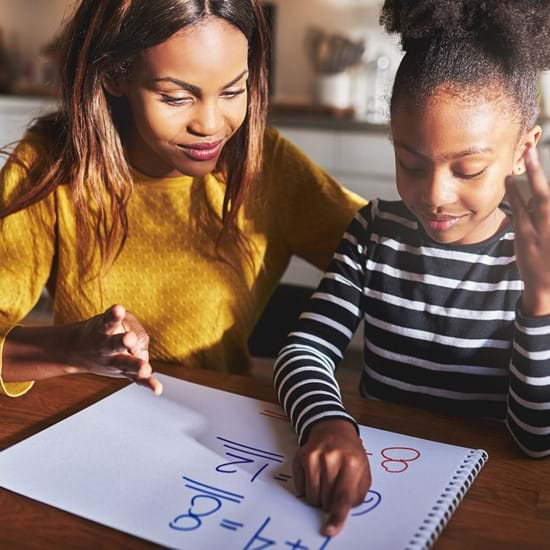
Learning to Learn

Written by: Marielle Potvin
Now that Lea is old enough to take in skiing, she gets to hit the slopes with her parents. Better yet, she gets to be placed under the care of a ski instructor. "Welcome kids! We will teach you how to ski ... simply by skiing. There’s no need to waste time on preliminary explanations; watching and practicing is how we learn. By the end of the season, you should be able to hurtle down the slopes as intermediate level skiers. Let's begin! Do as I'm doing!"
In this first lesson, students are instructed to ski down the slope. While Sophie is barely able to stand, William seems more balanced and natural at it; a situation which clearly has something to do with the fact that he got to practice a bit with his dad before lesson number one. However, the situation for Lea is a different story as she cries and struggles to stay upright on her two skis.
Here's the picture after a few Saturday lessons. Slight progress is noted for Sophie and some of her fellow skiers; William is among those who are already thinking ahead to the Olympic Games; Lea, on the other hand, informed her parents that she was through with the lessons, and that she would NEVER return.
Now here’s the picture at the end of the season, according to the instructor's assessment of skills. Sophie pulls it off for an entire run but fails the test because she falls repetitively; William comes through with flying colours; as for Lea, she remains unable to stay standing on her skis for more than 30 seconds. (Her parents remain unimpressed with her skills.) If only they knew.
Thinking of it, shouldn't we take into consideration that perhaps, some children may need to undergo the process of learning to learn?
Learning to ski involves a variety of things, including a number of lessons to be explicitly taught. Why wouldn't the same logic apply for every learning target?
What if we taught children how to learn? What if we clearly guided them through the challenge of maintaining attention and concentration, storing information and developing insight?
Given the extensive knowledge available about the different aspects of the learning process, and the many ways to learn, we are in a fairly good position to offer William, Sophie and Lea a better chance of succeeding.
Similarly, it is now possible to teach children how to make maximum use of their potential. Here are two pointers to this end:
First off, remember it is of no use to repeatedly remind a child to pay attention.
Rather, explain to him how paying attention works ― namely, by watching (and not simply seeing) and by listening (and not simply hearing). Once this subtle lesson is learned, the child can develop the ability to watch and listen with the intention of reproducing the object of learning in his own mind (what's been watched and heard), even when that projection fades off and is no longer present.
Although some practice is needed, results are likely to start to show quickly. Whether it's swimming or skiing, any student must first obtain adequate explanations of the repetitions before progress can be made.
Second, remember it is of no use to repeatedly remind a child to study, learn and memorize.
What if we rather taught him how to use his memory? This is much easier than one might think! Once the child has acquired the skill of focusing his attention, he can develop the ability to memorize learning objects ― multiplication tables or capital cities are good examples ― by cultivating the idea that these information items will be useful in the future. Only in this way can the learning be stored in the memory for longer terms.
Information items, such as multiplication tables, cannot be memorized merely by seeing or reciting them while the mind is wandering about with different thought objects. Instead, children and adults alike must use their imagination and put it at the service of the memory. To explain this notion, I often give the example of a person's name or phone number. (We all have been in a situation where a number is given to us when we have no pen and paper.)
Suppose for a moment that the object we’re going to focus in is the name of the contact person that will help us land our dream job, or a phone number we must dial the very next day in order to obtain something we deem important. A mental image is then instinctively projected into the mind; this projection is used to visualize ourselves dialling the desired number. In the process, the projected experience will literally stick in memory. These mental images (projections, relations between thoughts, mnemonic tips, etc.) are all concrete actions to remember worthy information in due course. Try it sometime and you’ll see the result!
These are just a few examples of insights on how to help children and students succeed; these tips are invaluable, provided we show them the way.
Antoine de La Garanderie was the first to frame what was called “Mental Management,” a pedagogical theory in which he investigates the reasons why pupils succeed or fail and sheds light on the different mental processes one uses in order to think, reflect, understand and learn.
On a more local scale, it is to Remedial Teacher, José Racicot, that we owe the popularization of the “Mental Management” approach for parents and teachers. In her book, entitled “J’apprends à penser, je réussis mieux,” she addresses the different ways to help us better support children with learning difficulties. A reader would be called upon to understand how the ski instructor could improve the way he attends to the learning needs of Lea in order to get her to hit the slopes with a certain measure of skill and fun.
José Racicot also offers training sessions via her blog. Speaking as a former participant, these resources prove quite useful for parents and teachers in helping children and students learning to learn.
Finally, the skill of knowing how to pay attention, think, memorize and learn holds the key to academic success for children who all too often feel helpless in the face of learning challenges such as those experienced by Lea.
- Josée Racicot, Orthopédagogue (French only)
- La Fédération des Associations Initiative & Formation (French only)
- http://www.gestionmentale.org/ (French only)

Marielle Potvin, Remedial Teacher
Follow me on Facebook: https://www.facebook.com/marielle.potvin
Email: marielle.potvin@gmail.com


